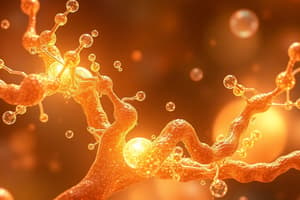Podcast
Questions and Answers
What is a primary reason carbohydrates are named so?
What is a primary reason carbohydrates are named so?
- They contain no chiral centers.
- They are derived from simple sugars.
- They are produced exclusively by animals.
- They have a general formula of Cn(H2O)n. (correct)
What role do carbohydrates play in cell membranes?
What role do carbohydrates play in cell membranes?
- They provide thermal insulation.
- They serve as an energy source.
- They act as structural components in cell walls. (correct)
- They facilitate DNA replication.
Which statement about monosaccharides is true?
Which statement about monosaccharides is true?
- Dihydroxyacetone is the only monosaccharide without chiral centers. (correct)
- They are always used for energy storage.
- They all contain a chiral carbon atom.
- Monosaccharides cannot exist in optically active forms.
What determines the interaction of carbohydrates with other biomolecules?
What determines the interaction of carbohydrates with other biomolecules?
What is the function of the TAS1R2 and TAS1R3 proteins?
What is the function of the TAS1R2 and TAS1R3 proteins?
What is a characteristic of sugar stereoisomers?
What is a characteristic of sugar stereoisomers?
Which type of carbohydrates serves as building blocks for larger polymers?
Which type of carbohydrates serves as building blocks for larger polymers?
What is one of the biological functions of glycoconjugates?
What is one of the biological functions of glycoconjugates?
Which of the following correctly describes an aldose?
Which of the following correctly describes an aldose?
What type of sugar is sucrose?
What type of sugar is sucrose?
Which sugar is considered a five-carbon standard sugar?
Which sugar is considered a five-carbon standard sugar?
What defines an epimer?
What defines an epimer?
Which statement about the cyclic structures of monosaccharides is true?
Which statement about the cyclic structures of monosaccharides is true?
What type of carbohydrate is formed following the oxidation of aldoses?
What type of carbohydrate is formed following the oxidation of aldoses?
What is the purpose of glucose oxidase in colorimetric glucose analysis?
What is the purpose of glucose oxidase in colorimetric glucose analysis?
How do intramolecular cyclic structures affect the reactivity of monosaccharides?
How do intramolecular cyclic structures affect the reactivity of monosaccharides?
Which of the following is a characteristic of polysaccharides?
Which of the following is a characteristic of polysaccharides?
What is the relationship between glucose and fructose?
What is the relationship between glucose and fructose?
What are glycosaminoglycans primarily composed of?
What are glycosaminoglycans primarily composed of?
Which component of the extracellular matrix provides strength and elasticity?
Which component of the extracellular matrix provides strength and elasticity?
What role do proteoglycans play in cellular function?
What role do proteoglycans play in cellular function?
Which of the following is a characteristic of glycoproteins?
Which of the following is a characteristic of glycoproteins?
What is a primary function of glycolipids in cellular membranes?
What is a primary function of glycolipids in cellular membranes?
What is the role of glycosphingolipids primarily found in neurons?
What is the role of glycosphingolipids primarily found in neurons?
Which type of glycan is crucial for determining blood groups in vertebrates?
Which type of glycan is crucial for determining blood groups in vertebrates?
What principle underlines the function of molecular interactions in biological systems?
What principle underlines the function of molecular interactions in biological systems?
What bond type is involved in the formation of disaccharides?
What bond type is involved in the formation of disaccharides?
Which of the following best describes glycogen?
Which of the following best describes glycogen?
What type of polysaccharide is characterized by having no defined molecular weight?
What type of polysaccharide is characterized by having no defined molecular weight?
Which enzyme is active in the small intestine after the pH is neutralized?
Which enzyme is active in the small intestine after the pH is neutralized?
What is the structure of amylopectin?
What is the structure of amylopectin?
How does salivary α-amylase affect starch and glycogen?
How does salivary α-amylase affect starch and glycogen?
What can lead to lactose intolerance in the adult population?
What can lead to lactose intolerance in the adult population?
Which statement accurately describes the glycosidic bonds in polysaccharides?
Which statement accurately describes the glycosidic bonds in polysaccharides?
What is maltose formed from?
What is maltose formed from?
Flashcards are hidden until you start studying
Study Notes
Carbohydrates Overview
- Named due to the general formula Cn(H2O)n.
- Synthesized from CO2 and H2O through photosynthesis in plants.
- Molecular weights range from glyceraldehyde (90 g/mol) to amylopectin (200,000,000 g/mol).
- Sugar stereoisomers occur due to chiral centers, influencing interactions with enzymes.
- Enzymes acting on sugars are stereospecific, demonstrating a preference for certain isomers.
- Carbohydrates can form glycoproteins and proteoglycans via covalent links with proteins.
Functions and Properties of Carbohydrates
- Serve as energy sources and storage.
- Act as structural components in cell walls and exoskeletons.
- Function as informational molecules for cell-cell signaling.
Monosaccharides and Their Characteristics
- Monosaccharides are simple sugars with one polyhydroxy aldehyde or ketone unit (e.g., D-glucose).
- Dihydroxyacetone is the only monosaccharide without chiral centers.
- Exist in optically active forms; most common type is D-series.
- Sweet taste perception is linked to TAS1R2 and TAS1R3 receptors.
Types of Carbohydrates
- Disaccharides consist of two monosaccharides (e.g., sucrose = glucose + fructose).
- Oligosaccharides are short chains of monosaccharides linked by glycosidic bonds.
- Polysaccharides consist of 10+ monosaccharide units (examples include cellulose and glycogen).
Aldoses vs. Ketoses
- Aldoses contain an aldehyde group.
- Ketoses contain a ketone group.
Structural Variants of Sugars
- Ribose and glucose are standard five- and six-carbon sugars, respectively.
- Galactose is an epimer of glucose, differing at one carbon atom.
- Fructose is the ketose form of glucose.
- Monosaccharides can cyclize, forming new chiral centers (anomeric carbons).
Variants of Hexoses
- Hexose derivatives include phosphate esters and oxidized forms (aldonic and uronic acids).
- These derivatives can form lactones, which are stable intramolecular esters.
Glycosidic Bonds and Polysaccharides
- Disaccharides form through glycosidic bonds between anomeric and hydroxyl carbons (e.g., maltose from two glucose units).
- Polysaccharides can be homopolysaccharides or heteropolysaccharides and vary in branching and linear forms.
Storage Forms of Energy
- Glycogen and starch are primary storage forms of carbohydrates.
- Glycogen: branched structure of glucose with (α1→4) chains and (α1→6) branch points.
- Starch consists of amylose (unbranched) and amylopectin (branched).
Digestion of Carbohydrates
- Glycosidases in saliva and intestines hydrolyze glycosidic bonds, with specificity to structure.
- Salivary α-amylase and pancreatic α-amylase are crucial for starch digestion.
- Intestinal disaccharidases convert disaccharides to monosaccharides for absorption.
Absorption and Metabolism
- Monosaccharides are absorbed in the small intestine via active and facilitated transport.
- Disaccharidase deficiencies can lead to digestive disorders such as lactose intolerance.
Glycosaminoglycans and Extracellular Matrix
- Glycosaminoglycans are linear polymers made of repeating disaccharide units (e.g., hyaluronan).
- They play essential roles in the extracellular matrix, providing structure, strength, and elasticity.
Glycoconjugates
- Biologically active molecules consisting of carbohydrates bound to proteins or lipids.
- Include proteoglycans, glycoproteins, glycolipids, and glycosphingolipids.
- Proteoglycans are involved in cell signaling and are integral to the extracellular matrix.
Molecular Complementarity
- Fundamental to the function of glycosylated molecules, affecting interactions and recognition between biomolecules.
Studying That Suits You
Use AI to generate personalized quizzes and flashcards to suit your learning preferences.




